HTC 10 vs Galaxy S7: Which Android flagship is better?
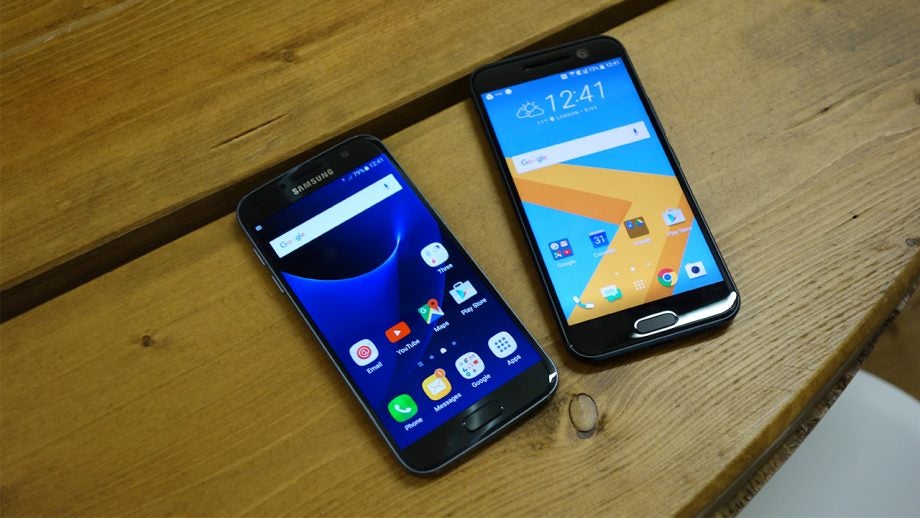
HTC 10 vs Galaxy S7: How do HTC and Samsung’s flagship phones compare?
After last year’s underwhelming One M9, and the equally disappointing One A9, HTC has come back with a bang and released the fantastic HTC 10. It’s best phone, probably, ever.
But how does the latest handset stack up against what might be the finest flagship on the market: the Samsung Galaxy S7?
Let’s take a look at how the two phones compare.
HTC 10 vs Galaxy S7: Design
HTC 10: 9mm thick, 161g, all-metal body, Carbon Grey/Topaz Gold/Glacier Silver
Galaxy S7: 7.9mm thick, 152g, metal alloy, glass front and back, IP68 certified, Black/Gold
Samsung’s latest effort continues the refined approach started by the Galaxy S6. The Galaxy S7 os a seriously sleek-looking device, which uses metal and glass to create an elegant and modern look.
In much the same way, the HTC 10 is made of 2.5D glass with a metal unibody. That 2.5D is more than a clever-sounding label designed to sell smartphones too. It refers to the slight curve at the edge of the display glass, which, when considered alongside the HTC 10’s bold chamfers, means the handset joins the S7 in having a somewhat rounded aesthetic.
Related: HTC 10 vs HTC One M9
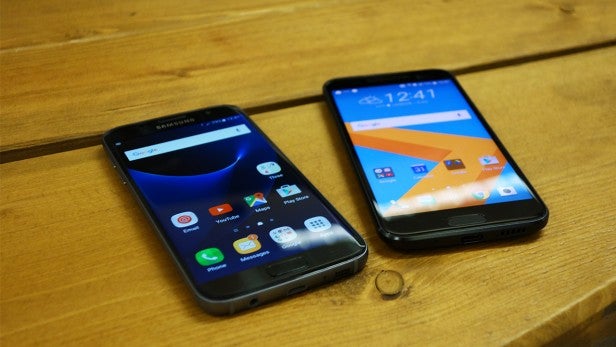
Unlike Samsung’s phone however, the HTC 10 eschews any logos on the front of the device, making for a simple and elegant design. Think the One A9 without the logo. The capacitive buttons, dropped from the M9 and A9, make a return, giving the HTC 10 something else in common with the S7.
At 3mm at the thinnest point, the HTC 10 is thinner than Samsung’s 7.9mm S7. It also comes with more colour choices. While the S7 comes in either black or gold, the HTC 10 comes in grey, silver, or gold.
One of the big features of the S7 has been the return of waterproofing, which was dropped for the S6. With an IP rating of 68, the S7 can be submerged in up to 1.5 metres of water for 30 minutes. Unfortunately, the HTC 10 lacks such a feature, so make sure you’re not the clumsy type if you’re planning on picking up HTC’s handset.
- Buy now: Samsung Galaxy S7 on EE (5GB) for £27/month
- Buy now: Samsung Galaxy S7 on Vodafone (16GB) for £36/month
Both the S7 and HTC 10 also feature a fingerprint scanner which has been placed below the home button on both handsets. However, while the S7’s home key is a proper clickable button, the HTC 10’s is merely capacitive. We prefer Samsung’s physical approach here.
Overall, these are two of the nicest looking and feeling phones on the market, and the winner on the design front really comes down to personal preference.
HTC 10 vs Galaxy S7: Display
HTC 10: 5.2-inch Super LCD5, 2,560 x 1,440, 565ppi
Galaxy S7: 5.1-inch Super AMOLED, 2,560 x 1,440, 577ppi
When it comes to screens, there’s no doubt the S7 has the nicest display available. The S7’s 5.1-inch quad-HD display makes for an impressive 577-pixel-per-inch density. Not to be outdone, HTC has loaded its new handset with a 5.2-inch quad HD display which features a comparable 564 pixel-per-inch density.
Watch: HTC 10 video review
In terms of resolution and ppi ratings then, there’s very little to distinguish the phones. However, it’s worth noting that the HTC 10 uses LCD technology (Super LCD5 to be precise), whereas Samsung has stuck with its AMOLED tech for the S7.
Both technologies have their attendant benefits and drawbacks, and which you prefer will come down to personal opinion. While blacks will be much deeper on the S7, the HTC 10 is naturally able to produce brighter images thanks to the LCD backlight, which is useful for outdoors viewing. On that last point, however, we should point out that the Galaxy S7 manages to bolster its brightness further when it’s outside.
Related: Best Samsung S7 deals
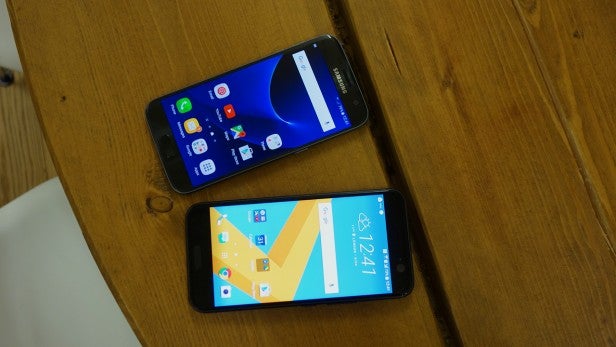
While the HTC 10’s display covers 99.9% of the sRGB colour gamut, it can’t hope to match the Galaxy S7 for pure eye-popping colour.
Of course, being LCD, HTC’s handset was always unlikely to feature the always-on technology that comes with the S7. Although LG managed to pull it off with the LG G5 handset, having the screen constantly display the time and notifications is much easier with an AMOLED screen as only the required pixels are illuminated rather than the entire screen. HTC could have gone the LG route and made it so that a portion of the HTC 10’s screen stayed illuminated to allow for an always-on display. Alas, they have not.
Interestingly, there is one area in which the HTC 10 seems to outdo the S7, albeit a fairly negligible one. HTC claims its handset has the fastest touchscreen available, with a response time of 120 milliseconds. The S7 only manages 163. In practice you’re unlikely to notice the difference, but it’s nice to see HTC trying to improve in areas you don’t often hear about.
One slight flaw with the HTC 10, which we found in our review, was a slight pinkish tinge when viewed at a slight angle. But it’s not deal breaker.
Overall, however, we have to give the display crown to Samsung. The Galaxy S7’s AMOLED screen is simply the best mobile display on the market, with the HTC 10 competing with its other rivals to be the best of the rest.
- Buy now: Samsung Galaxy S7 on EE (5GB) for £27/month
- Buy now: Samsung Galaxy S7 on Vodafone (16GB) for £36/month
HTC 10 vs Galaxy S7: Performance
HTC 10: Snapdragon 820 quad-core CPU, Adreno 530 GPU, 4GB RAM
Galaxy S7: Exynos 8890 octa-core/Snapdragon 820 quad-core CPU, Mali-T880 MP12/Adreno 530 GPU, 4GB RAM
So what’s powering these two flagship handsets? Firstly, the processor. Samsung’s choice to load the US version of the S7 with the Snapdragon 820 and all other S7 handsets with its Exynos 8890 chip has been well-documented. In practice, there’s certainly some performance differences between the two but on the whole, both are among the fastest processors available.
When it comes to HTC 10, you’ll be getting the same Snapdragon 820 that can be found in the US versions of the S7. On top of that you’ll be getting 4GB of RAM, which is the same as both the S7 and the S7 Edge. Essentially, you can expect speedy performance from both Samsung and HTC’s handsets.
In our benchmarks, the Exynos-equipped Galaxy S7 came out convincingly on top in the Geekbench 3 tests, while the HTC 10 pipped its to the post on AnTuTu. In truth, though, we’ve hit a bit of a plateau in terms of smartphone performance. Such figures ring a little hollow when real world performance is so universally strong.
Related: What is USB-C?

In terms of storage, both the S7 and HTC 10 come in either 32 or 64 GB options – at least on paper. In practice, here in the UK, the S7 only comes in 32GB guise as far as we can see. Both phones have an additional Micro SD card slot, allowing you to add up to 128GB extra memory.
Elsewhere, HTC has added a USB Type-C port, something which Samsung chose to leave off its latest update. The addition of the latest USB technology isn’t just about future-proofing, it means you’ll be able to connect noise cancelling headphones from JBL which plug directly into the USB Type-C port. HTC has promised more USB Type-C accessories are to follow in the future, although quite what those will be remains unclear.
HTC 10 vs Galaxy S7: Camera
HTC 10: 12-megapixel, laser autofocus, OIS, f/1.8 lens, 1/2.3″ sensor, 1.55 µm pixel ‘Ultrapixels’, 4K video, 5-megapixel front camera with OIS
Galaxy S7: 12-megapixel, phase detection, Dual Pixels, OIS, f/1.7 lens, 1/2.6″ sensor, 1.4 µm pixel, 4K video, 5-megapixel front camera
One big feature Samsung was keen to emphasise during the S7 launch was the new camera technology. Although, on its face, it seemed the company was taking a step backwards from the S6’s 16MP camera, with the addition of a 12MP camera on the newest handsets, a newly rebuilt sensor means the S7 is capable of taking incredibly detailed low-light pictures.
Dual Pixel technology allows the camera to lock onto a target much quicker than before. It makes for an extremely quick autofocus which might be the best smartphone camera autofocus we’ve seen.
It’s a similar story with the HTC 10, at least on paper. The handset comes with a 12MP camera which sees the return of the ‘UltraPixels’, previously dropped from last year’s handsets. ‘UltraPixels’ are essentially the same as can be found on the S7: enlarged pixels that help the sensor to capture better low-light images. However, they’re even bigger in the HTC 10 – we’re talking 1.55 µm pixels vs 1.4 µm on the S7. There’s also improved auto-focus (though it’s not as good as the S7) and a brand new camera interface.
Related: Samsung Galaxy S7 vs S7 Edge
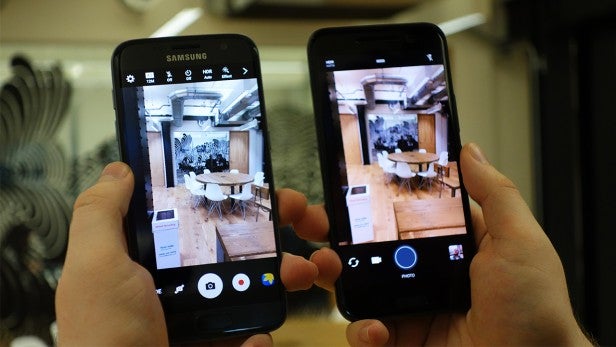
In terms of shooting experience and image quality, the Samsung Galaxy S7 wins out. Samsung’s algorithms just seem to get more solidly convincing every year, and the S7 simply turns out more reliably great images. The HTC 10 is a big improvement on previous models, but it still occasionally struggles with light metering, particularly when there’s a bright element in the frame.
The HTC 10’s camera also takes a few milliseconds longer to boot up than we’d like, while the Samsung Galaxy S7 is lightning quick – something that’s helped by that eternally great double home button tap shortcut prompt.
On the front of the HTC 10 you’ll find a 5MP lens, which is the same as the front-facing camera on the S7. However, HTC has added optical image stabilisation (OIS) to the front camera, making the HTC 10 the first smartphone to feature the technology on a front-facing lens. If you’re looking to shoot the best selfies possible, HTC’s handset is the better bet.
WATCH: Samsung Galaxy S7 review
HTC 10 vs Galaxy S7: Battery
HTC 10: 3000 mAh battery, 27hr talk time
Galaxy S7: 3000 mAh battery, 22hr talk time
Samsung managed to fix the somewhat underwhelming battery life of the S6 with its latest offerings. The S7 comes with a non-removable 3,000 mAh battery, which is more than you’ll need to get you through the day.
HTC has ensured its device can compete. With a 3,000 mAh non-removable battery, the HTC 10 matches the S7, and will easily give you a full day’s use. I found that it performs about as well as the Galaxy S7, which you’d expect given the similarities in performance, display size and sharpness, and battery capacity.
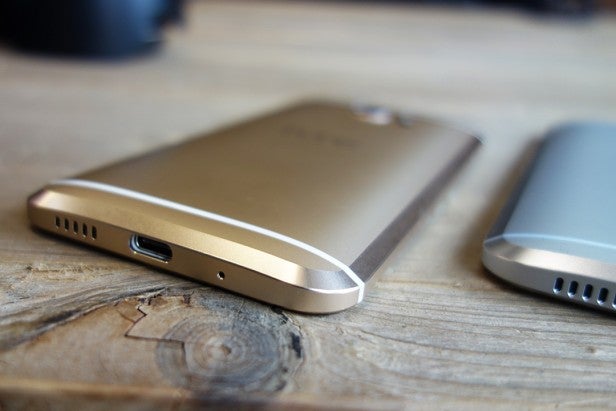
Don’t be fooled by HTC’s claims of a two-day battery life – in normal day to day usage you’ll fall short of that, but it’ll last through a solid day of usage without issue. We found that we could get an average of three hours’ screen-on time per day with the HTC.
Just like the S7, then.
What’s more, with Qualcomm’s Snapdragon 820 comes Quick Charge 3.0 technology, which can charge compatible devices up to four times faster than a conventional charger. We found that it would juice up fully in just under an hour.
Interestingly, even though the US version of the S7 uses the Snapdragon 820 chip, the S7 only supports Quick Charge 2.0. While that still means you’ll be able to charge your phone very quickly – just over an hour in our experience – it does mean that the HTC 10 has the edge when it comes to charge times.
HTC 10 vs Galaxy S7: Software
HTC 10: Android 6.0.1 Marshmallow, Sense 7.0 UI
Galaxy S7: Android 6.0.1 Marshmallow, TouchWiz UI
Both the HTC 10 and Galaxy S7 run on Android Marshmallow. One of the biggest complaints about Samsung’s previous devices has been regarding TouchWiz, Samsung’s own Android skin which it overlays on top of the standard interface. Icons are made to look different, the notification shade is altered, and you get a load of extra apps that do the same things as stock Android apps.
With the S7, Samsung managed to tone down just how intrusive TouchWiz is, although it’s still noticeably different – and just plain inferior – to stock Android.
HTC, on the other hand, is offering an experience much closer to how Google intended it. While you’ll still get the company’s own Android skin, it’s far less intrusive than TouchWiz. On top of that, HTC says it has worked with Google to remove many of the duplicate apps, making for a refreshingly clean app drawer. There’s only one music player, email client, and gallery app, and they’re all Google’s.
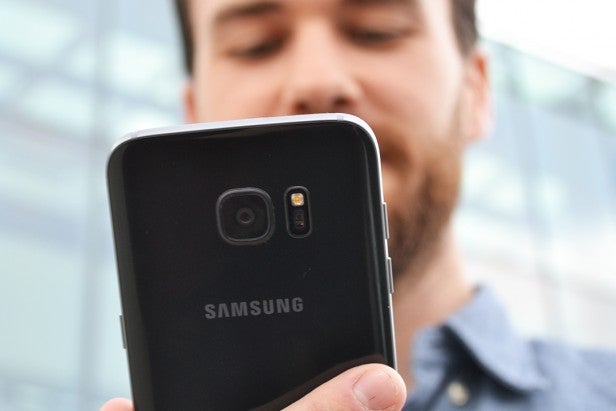
Plus, HTC has applied Google’s Material Design to those of its Android apps and features it has included.
The HTC 10 also comes with a new ‘freestyle’ layout, allowing you to lay apps anywhere on the screen as opposed to them being constricted to a pre-set grid. You can also use the HTC 10’s finger-print scanner to lock apps, and if all that wasn’t enough the date, time, and weather widgets are also higher res.
While both HTC and Samsung use Android 6.0 Marshmallow then, it’s the HTC 10 that does a better job customising it. The core functions are the same, but HTC has gone to greater lengths to address the concerns of those who continue to bemoan the use of overly intrusive custom skins for Android.
It’s resulted in an OS that’s arguably superior to the stock Android experience, while Samsung’s is still slightly inferior.
HTC 10 vs Galaxy S7: Audio
HTC 10: Hi-Res audio, BoomSound speakers
Galaxy S7: Single speaker
HTC aren’t pulling any punches this year when it comes to speakers. The HTC 10 comes with BoomSound speakers, meaning you get a tweeter at the top of the phone and a subwoofer at the bottom. There’s a dedicated amplifier for each driver. It’s not quite as punchy or clear as the dual-stereo setup in the M9, but it’s a whole lot better than any of its opposition.
The HTC 10 also supports Hi-Res 24-bit audio, and it comes bundled with a Hi-Res set of earbuds that blow rival stock efforts out of the water. For this reason alone, the HTC 10 should be the first choice for audiophiles – even ahead of the LG G5.
When it comes to the S7, Samsung has chosen to keep the single-speaker setup found on the Galaxy S6. While the single speaker at the base of the handset is perfectly adequate for using speaker-phone and streaming the odd film, the S7 simply can’t compete with the HTC 10 when it comes to audio.
HTC 10 vs Galaxy S7: Price
HTC 10: £569.99
Galaxy S7: £569
Both of these flagship phones are on sale for £570. That’s a pretty steep price, but then you’re talking about the very peak of Android performance here.
Given that we’re immensely impressed with both handsets, and the top specifications and design expertise that have gone into them, we’re happy to say that both are worth the money.
- Buy now: Samsung Galaxy S7 on EE (5GB) for £27/month
- Buy now: Samsung Galaxy S7 on Vodafone (16GB) for £36/month
Still, with a bunch of very accomplished mid-range alternatives on the market, and the fact that Android phones tend to depreciate within months, these are definitely expensive.
(apester:570d210c1de2251249a2b74e)
HTC 10 vs Galaxy S7: Verdict
The Samsung Galaxy S7 and HTC 10 are two of the best smartphones on the market, as reflected in our respective reviews.
The journey to get to this point has been very different for the two companies involved. While the S7 is a continuation and refinement of the brilliance found in last year’s S6, the HTC 10 is a massive improvement over the M9. However, both arrive at a similar point at the top of the smartphone tree.
There’s no doubt that HTC has the advantage in some areas, particularly audio and software. HTC’s latest version of Sense remains closer to the Android Marshmallow source material than Samsung’s TouchWiz, and the tweaks and improvements seem better considered and executed.
Meanwhile the Galaxy S7 has the better camera and display, as well as benefitting from being waterproof and compatible with a variety of wireless charging standards.
We’d say that the better camera and display probably gives the Galaxy S7 the edge in a straight fight, but whichever phone you choose we doubt you’ll be disappointed.

